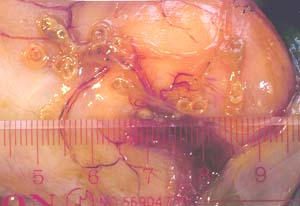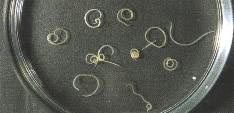Tokyo Food Safety Information Center » Good things to know »Food parasites »Anisakis – Nematode
Anisakis – Nematode
Anisakis Characteristics
| Color | Semi-transparent |
|---|---|
| Size | Around 2 to 3 cm long. Anisakis in parasitized fish are in their larval form. |
| Locations of parasitization | Primarily on the surface of internal organs, but muscle tissue can be parasitized as well. With salmon and trout, Anisakis larvae are frequently found in the muscles of the abdomen. |
| Characteristics | Anisakis frequently appear in a spiral shape and are encased in a semi-transparent mucous membrane pouch (a cyst). |
Effects on people
Anisakis larvae cannot transition into their adult form in humans and thus are normally excreted as part of waste matter. However, when parasitized fish is eaten raw, Anisakis can in rare cases penetrate into the human stomach and intestinal wall. When this occurs, the primary symptom of intense stomach pain occurs usually within eight hours of consumption. Other accompanying symptoms may include nausea, vomiting, and hives.
As these symptoms are similar to those for gastrospasm, stomach ulcer, and appendicitis, it is best to see a doctor for diagnosis.
Primary varieties of parasitized fish
Mackerel, salmon, Pacific herring, Japanese flying squid, sardine, Pacific saury, Okhotsk atka mackerel, Pacific cod, and trout. (Note that unless given live bait already parasitized by Anisakis, the parasitization of farmed fish by Anisakis is virtually unknown.)
Prevention methods
- Cooking with heat is the most effective means of prevention.
- Freezing for at least 24 at -20° C (until the center of the meat is frozen) will kill Anisakis. Note however, that wasabi, soy sauce, vinegar, and other condiments will not kill Anisakis in the amounts normally used in cooking.
- When making vinegared mackerel, one means of preventing Anisakis infection is to freeze the meat for at least 24 hours at -20° C (until the center of the meat is frozen) after salting and vinegaring the fish.
- Do not eat fish organs raw.
- When planning on eating raw fish, choose fresh products, remove internal organs as quickly as possible, and store seafood at low temperatures (4° C or less).
 Figure: Anisakis |
 Figure: Pacific cod parasitized by Anisakis |